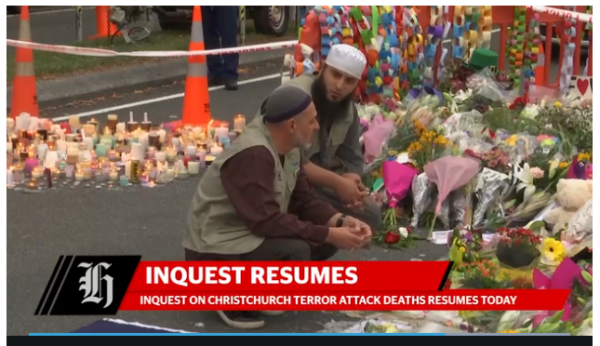The March 15 attack inquest resumes today, with the focus being on the door that would not open. As this attack inquest resumes, the government will be mindful they will want to cover every area that they had ignored, but without giving any information that contradicts their narrative to date.

This from NZ Herald:
A builder who helped repair Al Noor Mosque after the Christchurch terror attacks says the lock on the main prayer room’s emergency exit door may have created confusion and delay during the shootings.
The inquest into the deaths of the 51 worshippers murdered during the shootings on March 15, 2019, resumed on Monday.
Deputy Chief Coroner Brigitte Windley will hear evidence on that door over the next fortnight.
The emergency exit door was one of 10 issues the coroner heard evidence on between October 24 and December 15 last year.
During those seven weeks, the inquest heard from several witnesses who gave evidence about the door and its failure to open on the day of the attack.
However, the court had foreshadowed it might not be possible to hear all the evidence about the door during that fixture. Further evidence, including that of expert witnesses, was now required.
During last year’s hearing, survivors Mohammad Siddiqui and Ahmad Alayedy and Detective Senior Sergeant Damon Wells said the door – which was controlled by a mechanical lock and an electric magnetic lock – failed to open.
Siddiqui and Alayedy said they tried to unlock the door, then with another worshipper they kicked out the glass of its bottom pane and crawled through instead.
The door’s failure to open might have contributed to the deaths of 11 people.
Lyndon Moffitt, who helped repair Al Noor Mosque after the attack, told the coroner he had difficulty opening the door while working at the mosque on March 20, 2019.
The electromagnetic lock was turned off and was not working.
He pressed it a couple of times before noticing the mechanical lock.
Moffitt had to move his body into an awkward position before he could operate the mechanical lock.
The lock still offered some difficulty, but after wiggling the door he got the lock to function and the door opened, he said.
A brief of evidence from Khaled Al-Nobani was also read into evidence.
Al-Nobani said the lock was “very old” and could be “a little tricky” to get to work.
The door needed to be pulled inwards before turning the locking mechanism to get the door to open, his evidence said.
Due to the panic and the number of people pressing against the door in an attempt to flee the mosque during the attack, it was not possible to do that on March 15 2019, Al-Nobani’s brief said.
During questioning, Moffitt said the situation with the electromagnetic lock being turned off and the mechanical lock being difficult to access and operate would have created confusion during the panic of the shooting.
The mechanical lock on the door was not a satisfactory lock for an emergency door, he said.
The electromagnetic lock was installed in the days before the attack.
Christchurch terror attacks: Emergency door lock may have added to confusion, builder tells inquest

